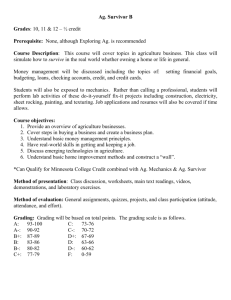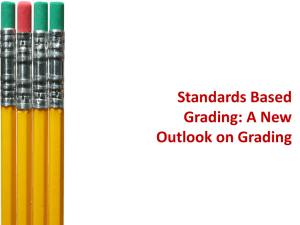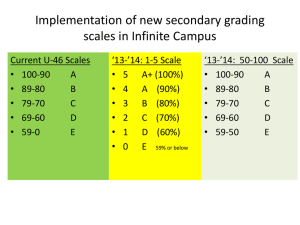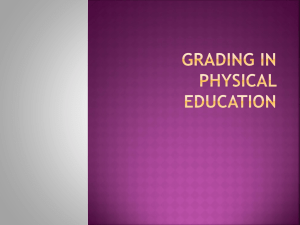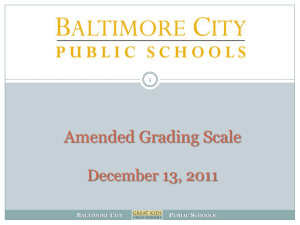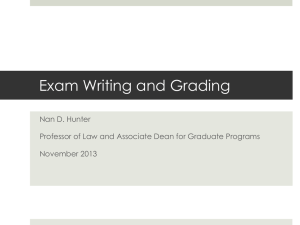How We Got Grading Wrong, and What to Do About It
advertisement
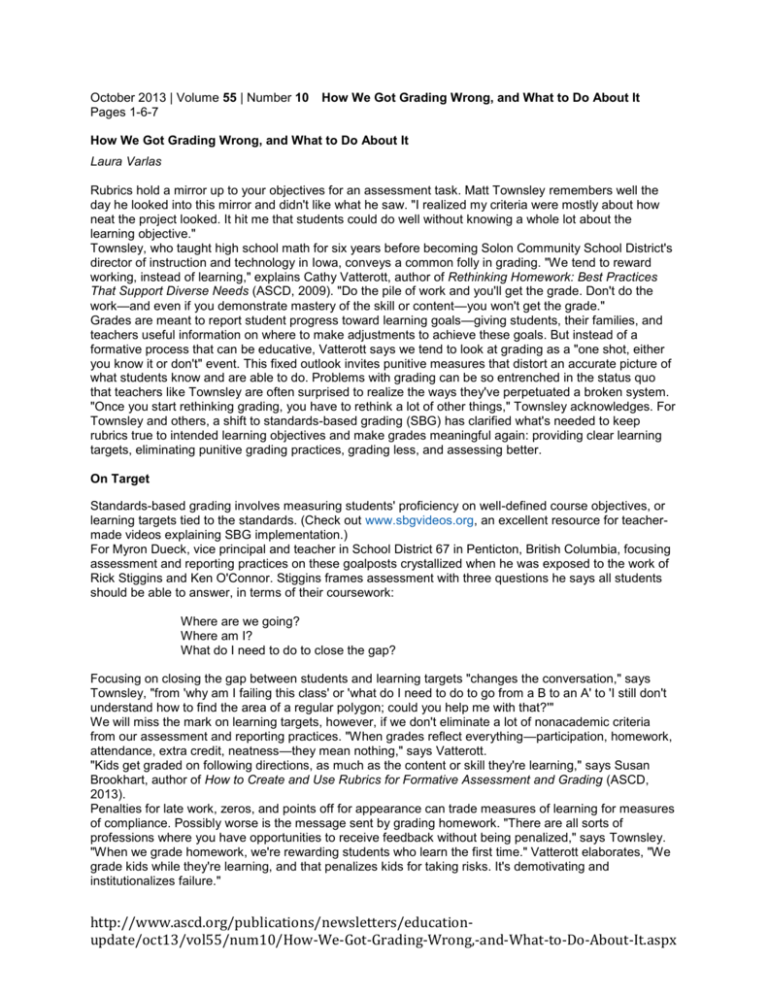
October 2013 | Volume 55 | Number 10 How We Got Grading Wrong, and What to Do About It Pages 1-6-7 How We Got Grading Wrong, and What to Do About It Laura Varlas Rubrics hold a mirror up to your objectives for an assessment task. Matt Townsley remembers well the day he looked into this mirror and didn't like what he saw. "I realized my criteria were mostly about how neat the project looked. It hit me that students could do well without knowing a whole lot about the learning objective." Townsley, who taught high school math for six years before becoming Solon Community School District's director of instruction and technology in Iowa, conveys a common folly in grading. "We tend to reward working, instead of learning," explains Cathy Vatterott, author of Rethinking Homework: Best Practices That Support Diverse Needs (ASCD, 2009). "Do the pile of work and you'll get the grade. Don't do the work—and even if you demonstrate mastery of the skill or content—you won't get the grade." Grades are meant to report student progress toward learning goals—giving students, their families, and teachers useful information on where to make adjustments to achieve these goals. But instead of a formative process that can be educative, Vatterott says we tend to look at grading as a "one shot, either you know it or don't" event. This fixed outlook invites punitive measures that distort an accurate picture of what students know and are able to do. Problems with grading can be so entrenched in the status quo that teachers like Townsley are often surprised to realize the ways they've perpetuated a broken system. "Once you start rethinking grading, you have to rethink a lot of other things," Townsley acknowledges. For Townsley and others, a shift to standards-based grading (SBG) has clarified what's needed to keep rubrics true to intended learning objectives and make grades meaningful again: providing clear learning targets, eliminating punitive grading practices, grading less, and assessing better. On Target Standards-based grading involves measuring students' proficiency on well-defined course objectives, or learning targets tied to the standards. (Check out www.sbgvideos.org, an excellent resource for teachermade videos explaining SBG implementation.) For Myron Dueck, vice principal and teacher in School District 67 in Penticton, British Columbia, focusing assessment and reporting practices on these goalposts crystallized when he was exposed to the work of Rick Stiggins and Ken O'Connor. Stiggins frames assessment with three questions he says all students should be able to answer, in terms of their coursework: Where are we going? Where am I? What do I need to do to close the gap? Focusing on closing the gap between students and learning targets "changes the conversation," says Townsley, "from 'why am I failing this class' or 'what do I need to do to go from a B to an A' to 'I still don't understand how to find the area of a regular polygon; could you help me with that?'" We will miss the mark on learning targets, however, if we don't eliminate a lot of nonacademic criteria from our assessment and reporting practices. "When grades reflect everything—participation, homework, attendance, extra credit, neatness—they mean nothing," says Vatterott. "Kids get graded on following directions, as much as the content or skill they're learning," says Susan Brookhart, author of How to Create and Use Rubrics for Formative Assessment and Grading (ASCD, 2013). Penalties for late work, zeros, and points off for appearance can trade measures of learning for measures of compliance. Possibly worse is the message sent by grading homework. "There are all sorts of professions where you have opportunities to receive feedback without being penalized," says Townsley. "When we grade homework, we're rewarding students who learn the first time." Vatterott elaborates, "We grade kids while they're learning, and that penalizes kids for taking risks. It's demotivating and institutionalizes failure." http://www.ascd.org/publications/newsletters/educationupdate/oct13/vol55/num10/How-We-Got-Grading-Wrong,-and-What-to-Do-About-It.aspx Grade Less Traditionally, all homework, quizzes, and tests go into a grade book. Townsley admits it was an uneasy shift to see homework—and eventually, quizzes—as practice, not points toward a summative score. He thinks about it in terms of a sports team or a band—how well you practice never ends up in the paper. "If you have a bad week practicing, you don't show up Friday night with minus five on the scoreboard." Teachers using SBG often keep a record of whether homework is completed and focus substantive feedback where students struggle. Homework carries no weight except in its worth for practicing for the assessment. Once Dueck changed the motivation from compliance to getting better at something, he saw struggling learners doing homework and making cue cards for a test, when before, they wouldn't have even considered it. "Kids find intrinsic motivation," notes Dueck, "because they are able to take risks, selfassess, adjust, practice, and find what works best for them, to learn something." Vatterott adds that schools giving feedback for homework instead of points have seen a decrease in cheating because "there's no point to it—it's not going to help you pass the test." "Not grading homework freed me up to focus on feedback, instead of factoring grades," says Townsley. He adapted his quizzes to be better vehicles for feedback by adding a Likert scale. Students would rate their level of knowledge of a standard before a quiz. Then, after students took the quiz, Townsley would add qualitative feedback and rate where he thought students were on the continuum of learning so that they would know before a project or test what they needed to work on. "There were fewer numbers going in the grade book, but I was getting the right information to the right students while there was still time for learning." If quota requirements or just personal preference push you to enter homework or other formative assessments as grades, Vatterott recommends entering them as no-weight scores—evidence of what a student is doing—to be informative, not punitive. Assessment Refined After Dueck constructed unit plans with clear learning targets and eliminated punitive grading practices, the next logical step—admittedly a terrifying one—was to overhaul his tests so that they would be much more amenable to retesting. He organized tests by topics nested in the standard that was being assessed so that he knew exactly where students were struggling and could focus reassessments in those places. Townsley also organized tests by standard or topic and gave back multiple scores tied to each section of the test, which allowed students to see their strengths and weaknesses. This provides powerful information to guide both student practice and instructional adjustments from the teacher. "When you offer retests, you might be surprised who shows up," says Dueck, recalling his 11th grade class of struggling learners. "I saw incredible things from these kids, and it came from them, finally, having some power over their education." For Townsley, reassessment is about acknowledging that "it's more important what you learn than when you learn it." Teachers wary of being trapped in an endless cycle of reassessing might want to start small, by allowing one retest, says Dueck, citing advice from standards-based grading advocate Thomas Guskey. Townsley adds that clearly communicated policies for reassessing make this practice successful. Because reassessing requires extra work from the teacher, students should have steps to earn reassessment—for example, redoing homework, attending tutoring, completing online learning modules, or creating their own lesson on the topic to be reassessed.09o Getting It Right Townsley, whose school is in a multiyear implementation where all teachers are using SBG, thinks of the old grading system as "assessments-based," while SBG puts students and learning at the center. Vatterott believes that standards-based grading is going to change the whole education paradigm. "In the http://www.ascd.org/publications/newsletters/educationupdate/oct13/vol55/num10/How-We-Got-Grading-Wrong,-and-What-to-Do-About-It.aspx past, time was fixed and achievement varied. Now we're saying, we want achievement to be fixed, but time [to demonstrate mastery] will vary." Dueck sees an opportunity for social justice. "We can do an awful lot to alleviate the effects of poverty by what we do with grades. It's time to consider to what extent our grading rules and assessment practices work to alleviate stressors and support students, rather than measuring, measuring, measuring." Be prepared to rethink everything once you open the door to grading reform, says Townsley. From the warm-up at the beginning of class to final grades, everything in Townsley's classroom became formativeminded, or about finding out "how well do my students know this? How might I change my instruction to improve that?" In the end, Townsley says, "It revolutionized my perspective on classroom instruction, assessment, and education in general." http://www.ascd.org/publications/newsletters/educationupdate/oct13/vol55/num10/How-We-Got-Grading-Wrong,-and-What-to-Do-About-It.aspx

